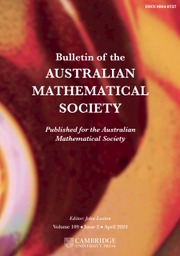No CrossRef data available.
Article contents
On the three-space problem for the Dunford-Pettis property
Published online by Cambridge University Press: 17 April 2009
Extract
Core share and HTML view are not available for this content. However, as you have access to this content, a full PDF is available via the ‘Save PDF’ action button.
A Banach space X is called a twisted sum of the Banach spaces Y and Z if it has a subspace isomorphic to Y in such a way that the corresponding quotient is isomorphic to Z. In this paper we study twisted sums of Banach spaces with either have the Dunford-Pettis property, are c0-saturated or l1-saturated. Amongst other things, we show that every Banach space is a complemented subspace of a twisted sum of two Banach spaces with the Dunford-Pettis property.
- Type
- Research Article
- Information
- Bulletin of the Australian Mathematical Society , Volume 60 , Issue 3 , December 1999 , pp. 487 - 493
- Copyright
- Copyright © Australian Mathematical Society 1999
References
[1]Bourgain, J. and Pisier, G., ‘A construction of ℒ∞-spaces and related Banach spaces’, Bol. Soc. Brasil Mat. 14 (1983), 109–123.CrossRefGoogle Scholar
[2]Brudnyi, Y.A. and Kalton, N.J., ‘Polynomial approximation on convex subsets of ℝn’, (preprint).Google Scholar
[3]Sánchez, F. Cabello and Castillo, J.M.F., ‘Uniform boundedness and twisted sums of Banach spaces’, (preprint 37 Uex, 1998).Google Scholar
[4]Castillo, J.M.F. and González, M., ‘New results on the Dunford-Pettis property’, Bull. London Math. Soc. 27 (1995), 599–605.CrossRefGoogle Scholar
[5]Castillo, J.M.F. and González, M., Three-space problems in Banach space theory, Lecture Notes in Mathematics 1667 (Springer-Verlag, Berlin, Heidelberg, New York, 1997).CrossRefGoogle Scholar
[6]Castillo, J.M.F. and Gonzalez, M., ‘The Dunford-Pettis property is not a three-space property’, Israel J. Math. 81 (1993), 297–299.CrossRefGoogle Scholar
[7]Castillo, J.M.F., González, M., Plichko, A.M. and Yost, D., ‘Twisted properties of Banach spaces’, Math. Scand. (to appear).Google Scholar
[8]Castillo, J.M.F., González, M. and Sánchez, F., ‘M-ideals of Schreier type and the Dunford-Pettis property’, in Non-associative algebra and its applications, (González, Santos, Editor), Math. Appl. 303 (Kluwer Acad. Press., Dordrecht), pp. 80–85.Google Scholar
[10]Kutzarova, D. and Troyanski, S., ‘On reflexive Banach spaces without equivalent norms which are uniformly convex or uniformly differentiable in every direction’, Studio Math. 72 (1982), 91–95.CrossRefGoogle Scholar
[11]Leung, D.H., ‘Some stability properties of c 0-saturated spaces’, Math. Proc. Cambridge Philos. Soc. 118 (1995), 287–301.CrossRefGoogle Scholar
[12]Leung, D.H., ‘On c 0-saturated Banach spaces’, Illinois J. Math. 39 (1995), 15–29.CrossRefGoogle Scholar
[13]Lindenstrauss, J. and Tzafriri, L., Classical Banach spaces I, sequence spaces (Springer-Verlag, Berlin, Heidelberg, New York, 1977).Google Scholar
[14]Odell, E., ‘On quotients of Banach spaces having shrinking unconditional bases’, Illinois J. Math. 36 (1992), 681–695.CrossRefGoogle Scholar
[15]Rosenthal, H.J., ‘On totally incomparable Banach spaces’, J. Funct. Anal. 4 (1969), 167–175.CrossRefGoogle Scholar
[16]Schreier, J., ‘Ein Gegenbeispiel zur Theorie der swachen Konvergenz’, Studia Math. 2 (58–62), 1930.CrossRefGoogle Scholar


